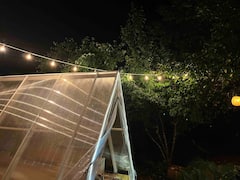Mention Korean food and the first thing that immediately pops up in our minds would be Kimchi (김치, spicy pickled cabbage). You may also be thinking about the flavourful Korean barbeque and the nutritious Ginseng Chicken Soup or Samgyetang (삼계탕) as the Koreans call it.
But wait, before you think Korea is a boring place for foodies, don’t pass this judgement so soon! There are many more delectable Korean food waiting to be discovered in the Land of the Morning Calm, and I shall recommend you 5 types of mouth-watering Korean food that you wish you had known about them earlier!
1. Andong Jjimdak (안동 찜닭)

Andong Jjimdak (안동 찜닭), as the name suggests, is a Korean dish that originated from the city of Andong in Gyeongsangbuk-do Province. It is a steamed chicken dish with starched noodles (Dangmyeon, 당면), various kinds of vegetables like cabbage, carrots, cucumber and potatoes marinated in a Korean spicy soy-based sauce. The dish can be quite spicy for those who can’t really take spicy hot food as lots of green and red chili peppers as well as ground black pepper are used to enhance the flavour of the dish.
Andong Jjimdak may have originated from Andong Gu Market’s chicken alley (안동 구시장 닭골목) since the 1980s, but it has become so popular that you can now find it in many other parts of Korea, including its vibrant capital - Seoul. This delightful dish is best enjoyed in a group as the portions are big and served on a large plate. It is nearly impossible to finish such a generous portion of juicy and tender chicken with lots of vegetables alone! Take the opportunity to bond with your friends and family while sharing the joy of eating this flavourful cuisine. Pair the Jjimdak with dongchimi (동치미, water-based kimchi with radishes) for an even more satisfying meal.
To have a taste of the authentic Andong Jjimdak at its birthplace, head to Andong Gu Market’s famous chicken alley. You may be lost on which is the restaurant serving the best Andong Jjimdak for there are plenty of restaurants selling the same dish. Look out for either of these 2 restaurants: Andong Yujin Braised Spicy Chicken (안동 유진찜닭) or Hyundae Jjimdak (현대 찜닭) located side by side in the market. Both are usually crowded with long queues of people waiting to tuck into the delicacy. Be patient as you join the queue to sink your teeth into the mouth-watering spicy dish costing around 25,000 KRW (22 USD). It is definitely worth the wait!
2. Trio of breads in Gyeongju city

Gyeongju city in Gyeongsangbuk-do Province is famous for its trio of breads - Gyeongju bread (경주빵), Hwangnam bread (황남빵) and Chalboribbang (경주 찰 보리빵 ). By American standard, they are not really breads but more like small bite-sized pastries.
The most famous of the trio is none other than the Hwangnam bread (황남빵), first baked in Hwangnam-dong, Gyeongju city in 1939. It is a unique pastry made from thin dough, with a generous amount of red bean paste filling made from red beans grown in Korea. Made without using any artificial sweeteners or preservatives, this sweet pastry has become so popular in the country that it has been designated as an “outstanding regional specialty” (지역명품) by the Korean government.
Similar to Hwangnam bread, Gyeongju bread (경주빵) is also filled with locally produced red bean paste, but it is less sweet and made with harder red beans. Nonetheless, it is also well-loved by locals and visitors to Korea, especially for those who prefer a less sweet version of the specialty.
Last but not least is the Gyeongju glutinous barley bread or Chalboribbang (경주 찰 보리빵 ). Consisting of two layers of pancake made from glutinous barley flour harvested in the fields of Gyeongju, red bean paste is filled in between the two layers. The chewy texture of this Chalboribbang is akin to biting into a slice of glutinous sponge cake, but it is something uniquely Korean that is hard to find elsewhere.
Given the popularity of the breads found in Gyeongju, many Korean bakeries are also producing them outside of Gyeongju and so you can find them easily in many places in the country. For the original version, check them out at Hwangnam Bread Bakery in central Gyeongju city where you can purchase them in boxes of either 20 or 30 pieces at 16,000 KRW (13.90 USD) or 24,000 KRW (20.85 USD) respectively! These are great as unique souvenirs from the lovely city. But if you would like to just buy a piece to try first, the price is around 700 KRW (0.60 USD) each, though there are some bakeries that only sell the delicacies in boxes.
3. Busan fish cake (부산 어묵)

Fish cake, or Eomuk (어묵) as the Koreans call it, is a processed seafood product that purees various cuts from white fish with salt, and steamed until fully cooked. Commonly found at push-cart stalls everywhere you visit in Korea, it is a popular street snack, particularly during winter when the piping hot fish cake soup or fish cake skewer gives you warmth in the chilly weather.
Busan, Korea’s second biggest city and a large seaport abundant with seafood, serves as a national hub for the fish cake business. Given its advantageous geographical location blessed with bountiful fresh fish supply, Busan fish cake is said to be the best fish cake in Korea today. The fish cake made in Busan is thicker with a stronger taste of fish compared to those found in other parts of the country.
Don’t believe me? Try them at the traditional wet market - Bupyeong Kkangtong Market (부평시장) - near Jagalchi Station (자갈치역 Busan Subway Line 1) exit 7, home to an alley that specializes in fish cake. The Eomuk comes in triangular and circular shapes, various sizes, colours and flavours, with additives such as mushrooms, carrots or cheese.
Other than the Bupyeong Kkangtong Market, ask any local which brand comes to mind when they think of Busan fish cake, and almost instantly, everyone will say it’s Samjin Fish Cake (삼진 어묵).
Samjin has been established since 1953 and the successful business is currently run by the third generation. They have 7 outlets just in Busan alone, as well as a few other outlets in the provinces of Seoul, Gyeonggi and Chungnam.
Head to the flagship store near Yeongdo Bridge where you can take your pick from the wide selection of fish cakes available. After a satisfying fish cake feast, you can even hop over to the Samjin Eomuk Museum (삼진어묵 박물관) next door to know all about Eomuk and have fun making the well-known fish cake yourself!
You might be interested in these Airbnbs!
4. Suwon's fried chicken

Fried chicken is one of Korea’s popular snacks to eat while drinking beer. Because of the Korean hit drama “My Love From the Star” (별에서 온 그대), Chi-Maek (치맥), i.e. the combination of fried chicken and beer, has gained so much attention that the surge in the popularity of Korean fried chicken has become a phenomenon.
Although restaurants selling fried chicken are found everywhere in Korea, special mention must be made to Suwon city in Gyeonggi Province where there is a special Chicken Street (치킨골목) dedicated to chicken restaurants with 40 years of tradition.
What is so special about Suwon fried chicken that is different from fried chicken that we can find even in our own hometowns? The whole chicken is fried in a traditional way in an iron pot, and the end result is you get really crispy and crunchy fried chicken, different from what is being served in the western fast food joints.
In these restaurants, you can’t order the fried chicken in pieces, as it is served in the form of whole chicken only. So it is best to do what the locals do, gather a group of friends for an enjoyable chat session with Chi-Maek. Before you know it, the addictive fried chicken will all be eaten and you may even ask for a second round!
GIven that every restaurant along this Chicken Street sells the famed chicken, how do you know which is the best? You can head to Yongseong Tongdak (용성 통닭) somewhere in the middle of the street to satisfy your cravings. A traditional fried chicken for 1 person costs 13,000 KRW (11.40 USD) and it comes with popcorn, pickled radish, as well as 3 types of unique sauces to go along with the yummy fried chicken.
5. Dak galbi (닭 갈비)

Last but not least, another popular chicken dish in Korea is the dak galbi (닭갈비). It is prepared by marinating chopped chicken in spicy red pepper paste for a day. Cabbage, green onions, sweet potatoes, and cylindrical rice cakes are then added with all ingredients placed in a large cast iron hot plate. The mixture is then typically stir-fried at the table. Dakgalbi can be enjoyed on its own or wrapped in lettuce leaves for an added crunchy taste. After most of the dak galbi has been eaten, rice is then stir-fried with the remaining chicken and sauce in the pan.
As a local specialty originating from Chuncheon city in Gangwon Province, the dish is also called Chuncheon dak galbi which is well-known for using fresh unfrozen chicken. Chuncheon dak galbi is so popular that an annual autumn festival dedicated to the delicious specialty is being held every year since 2005!
You can visit Chuncheon city’s Myeongdong Dakgalbi Street in Gangwon Province to sink your teeth into the original dak galbi. If not, you will be able to tuck into the mouth-watering dish in Seoul too, as it is relatively near to Chuncheon, so many dak galbi restaurants in Seoul import fresh chickens from the city to prepare this specialty too.
Check out Sin Mi Gyeong Traditional Roast Chicken (신미경 홍대 닭갈비) restaurant located in the trendy Hongik University district to satisfy your cravings. The best-selling item on the menu is the yummy Cheese Fondue dak galbi, which costs 13,000 KRW (11.40 USD) per person as seen in the picture above.
Enjoy your foodie tour in Korea
After reading this article, I hope you are excited about the 5 mouth-watering Korean specialties recommended and can’t wait to tuck into them! There are many more yummy local specialties waiting for you to discover in the country, so think twice before you say Korea is a boring place for foodies again! Enjoy your foodie trip!
History
Get Trip101 in your inbox
Unsubscribe in one click. See our Privacy Policy for more information on how we use your data




















Create an account to